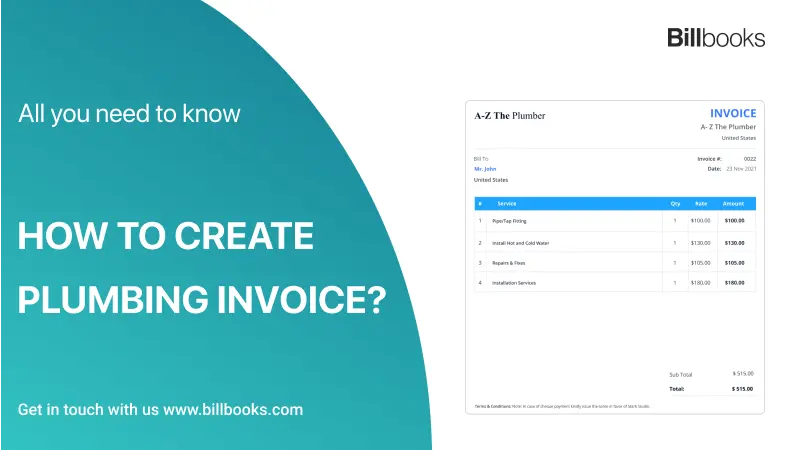From repairing and installation of pipes to other plumbing fixtures plumbers work on a one-off basis with several clients every day. Such a hectic schedule makes it hard to attend your invoicing process if you don’t have a thorough idea of this mechanism.
Pen and paperwork may seem simple and easy but this old-school method is way more time-consuming. After all the hard work you deserve to get paid properly and promptly and hence you need to adapt smarter techniques for evolve your invoicing process.
This article will guide you to understand how to create plumbing invoices effortlessly.
Let’s explore!
What is a plumbing invoice?
Like other businesses, plumbing jobs do require an invoice after completing the task. It includes the service list that has been provided by the company to its clients along with the due amount. It also states when and how to clear off the payment.
What is it used for?
Invoice is a must-have for tracking your finances, which helps to maintain a record of each and every transaction made. It goes without saying, no matter what business you are in, invoices avoid headaches when it’s time to file your taxes. It simply makes tracking your business finances seamless and helps you get paid on time.
Invoices vary depending upon the type of transaction you make like other business enterprises. Lookout in the section below to get an idea about the various categories of plumbing invoices.
Types of Plumbing Invoice
Running a plumbing business would bring about the mixed-bag experience. Therefore, you need a customized invoice that would suit the job type. So let’s first understand the types of invoices in plumbing jobs.
- Standard invoice: This outlines what the customer owes to the vendor and is very to the point.
- Recurring invoice: This is typically used for ongoing services and is generally issued after a fixed time period.
- Time-based invoice: This is used to bill the customer on hourly work. The hours worked for completing the task are tracked and the amount is charged accordingly.
- Prepayment invoice: This is used when you claim a down payment or deposit of a certain amount before completing the task.
- Mixed invoice: A mixed bag of credit and charges made to the client is logged in a mixed invoice.
- Debit invoice: Used when there is a significant rise in the remaining due amount.
- Credit memo: This is used to make a note of credit made to the client’s account.
Like other business invoices, plumbing invoices include similar details. Here’s what you need to add!
What all should be included in a plumbing Invoice?
A proper invoice is a must-have for all businesses. It must reflect who you are and what you are claiming for so that your clients get to know everything in one go. Refer to the below checklist to add all the essential information to your plumbing invoice.
- Contact Details
- ‘Invoice’ word
- Invoice number
- Invoice issue date
- Itemized list of services and corresponding price list
- Total amount due
- Taxes and discounts
- Payment due date
- Payment terms
- Personal note
Wondering how to create an invoice for your plumbing business? Check out the section below!
How to create a plumbing invoice in a few simple steps?
Creating a professional invoice has got easier with Billbooks. Simply add the detailed information and breakdown the cost for the ease of understanding. Here’s how you can do it!
- Format a professional-grade invoice by adding your business name and logo at the beginning.
- Add the word ‘Invoice’ in the bold and easy-to-see font for manual invoicing. You don’t even need to add this for automated processes like while using Billbooks..
- Now, it’s time to fill in the contact details of both client and yours. Make sure you add correct information as these might be referred to if required in the future.
- With Billbooks you get an auto-generated invoice number. So no head-breaking for creating a unique invoice number- it’s that simple!
- Invoice date is also pre-filled in Billbooks invoice template. You just need to set the invoice due date. Set it as per your payment terms to ensure no delay in payment.
- Most importantly, place your service description and corresponding charges without any error. This itemized list of job descriptions gives a clear picture as to where they are investing their dollars.
- Break down the cost, calculate the total, add in discounts and taxes (if applicable) and mention the total amount for clarity.
- Payment terms and conditions include payment mode, late payment penalties, etc. Such information would encourage your clients to clear payment on time.
- Save, preview, and immediately send your invoices. The best part is that you get notified for each step crossed that keeps you informed about the status of your invoice.
After all, you have learned about creating a plumbing invoice, the question arises when to send it. Here’s the answer to your question!
When to issue a plumbing invoice
After you are all set with your invoice, the best practice is to send the invoices immediately after you are done with your task. The process has gotten much easier with Billbooks. The invoice templates available here make it easy to customize it as per your requirement- add in the data- save, preview, and send it off.
Bottom line!
After all your hard work and invoice processing, if you are wondering how to get paid faster, then set your payment terms tactfully. Net-30 would be preferable for your old customers, whereas getting your payments cleared within 10 or 15 days for new ones.
Additionally, keep your payment mode online for a win-win situation. This not only eases up payment processing but also ensures faster payment.



